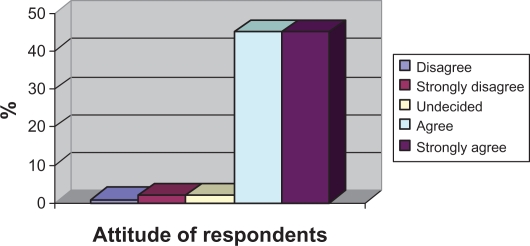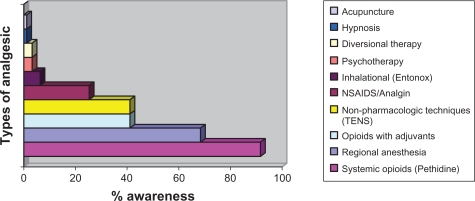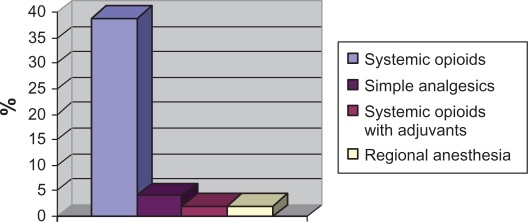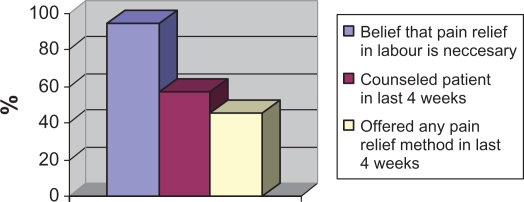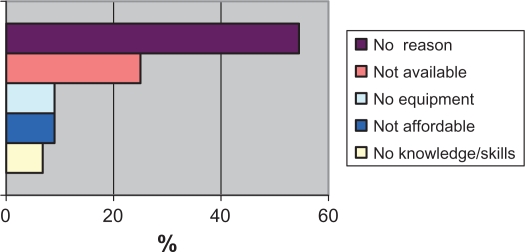Abstract
Background:
The purpose of this study was to assess the attitudes of maternal health care providers to pain relief during labor in Zaria, Nigeria.
Methods:
This was a multicenter, collaborative, cross-sectional pilot study of provider perspectives concerning pain relief during labor. A structured, self-administered, questionnaire was completed by 95 consenting maternal health care providers at three high-volume facilities in Zaria, an ancient northern Nigerian city. Descriptive statistics was performed on the data.
Results:
Most respondents (94.8%) agreed that pain relief is needed during labor. Only 2.1% of respondents were undecided about the provision of pain relief during labor and 3.2% were of the opinion that pain relief was not necessary during labor. Most respondents (93.7%) had attended a woman in labor in the 4 weeks preceding the survey. Of these, 56.8% had counseled a parturient in labor. Most of the counseling (42.1%) took place during labor. Less than half of the respondents (48.4%) had administered pain relief in labor in the preceding 4 weeks and systemic opioids was the most commonly form of pain relief. Among the respondents who did not offer pain relief agents in labor, the majority (54.5%) had no reason for not offering it. Unavailability of methods, inability to afford the cost of pain relief, lack of knowledge and skills, as well as lack of essential equipment to provide the procedure were also given by respondents as reasons for not offering pain relief.
Conclusion:
Even though maternal health care providers in this environment have a positive attitude to pain relief in labor, most women go through labor without the benefit of analgesia. There exists a gap between provider attitudes to pain relief in labor and practice of the same, with many providers having no genuine reason(s) for not offering pain relief to their clients during labor. Providers need to align their practice to their attitudes, and need to be helped to do this through training as well as enhancing their ability to think critically about their practice.
Keywords: pain relief, providers, attitudes, practice, labor, conflict
Introduction
Concerns about pain in labor are as old as mankind. Biblical texts contain vivid accounts on the origin of pain in labor and up until the present time, the medical and lay press have engaged in debates, sometimes fierce and enthralling, about the origin of labor pains, as well as their severity and relief. Accounts from the medical literature show that pain perception in labor varies in onset, timing, duration, and severity. Studies have shown that these variations relate to sociodemographic and biological variables like age, parity, race, religious affiliation, and ethnicity.1 Some studies even suggest a circadian variation in pain perception.2
Many pharmacologic and nonpharmacologic treatments have been developed to alleviate the labor pains, and their use has become popular, especially in developed countries. Treatments found to have been used at one time or another include parenteral opioids,3–5 epidural analgesia,6,7 and inhalational agents like nitrous oxide. The place of nonpharmacologic agents, like transcutaneous electrical nerve stimulation (TENS),8,9 hypnosis,10 and acupuncture11,12 to relieve labor pains has also been shown in many studies. The effectiveness of these methods varies. Overall, epidural anesthesia remains the gold standard, based on the findings of many researchers, including meta-analysis.7,13–15 The available evidence suggests that parenteral opioids are only somewhat effective and could even be harmful to the baby, yet are widely used.16–18 The evidence for effectiveness of nonpharmacologic agents like TENS, acupuncture, and hypnosis is also scanty, although there are isolated reports of efficacy.19–24
Pain relief during labor is desired by many women, irrespective of race or creed, and contributes immensely to their satisfaction with the experience of childbirth.25–27 Studies have shown that when women are offered analgesia during labor, they report greater satisfaction with their overall birth experience.28–30
According to the Nigerian Demographic and Health Survey findings in 2008, about 60% of pregnant Nigerian women attended antenatal care but only 35% of deliveries are in health care facilities.31 In this context, pain relief during labor could be a critical incentive for increasing facility deliveries. However, only a few published studies have addressed the prevalence, determinants, and severity of labor pains and the role of pain relief agents.1,20,32 The majority of deliveries occur at home and are largely attended by unskilled providers. With the strong belief grounded in culture and religion that pain is acceptable during labor, women who deliver at home rarely benefit from any modern pain relief.
Despite the finding that labor pains afflict a large proportion of Nigerian women, thereby making child birth a less than satisfactory experience, provision of analgesia for labor is infrequent.33 This may be as a result of several factors, including availability, health care delivery systems, knowledge, and choice of caregivers and clients. Of these, the attitude, knowledge, and skills of the provider to offer labor analgesia is paramount, especially in low income countries.
Methods
This was a descriptive, multicenter, collaborative, cross-sectional study at three high-volume hospitals in a city in northern Nigeria, involving 124 health care providers (including doctors, nurses, and midwives). All providers were contacted, counseled, and their verbal consent was obtained.
A self-administered and structured questionnaire was designed and pretested. The essential components of the questionnaire included provider background, awareness of pain relief with pharmacologic and nonpharmacologic agents, and the use of these for the relief of labor pains in the 3 months preceding the survey. The questionnaires were then delivered to the health care providers, who were given clear instructions on how to complete them. Data collection took place over a 2-week period in 2009.
Data were entered into SPSS for Windows (v 15; SPSS Inc, Chicago, IL), cleaned, and analyzed. Univariate and bivariate analysis was performed, and appropriate tests were carried out to determine significant relationships between the dependent and independent variables, with the level of statistical significance set at P < 0.05.
Results
Of the 124 health providers approached, 95 returned completed questionnaires, representing a response rate of 76.7%. Table 1 shows the age, gender, highest qualification attained, current position, and affiliation of respondents. The majority of the respondents “agree” and “strongly agree” that women should benefit from pain relief during labor and childbirth. Figure 1 shows the distribution of the responses. The respondents were asked to respond “No” or “Yes” to assess their awareness of pain relief agents. Their responses are shown in Figure 2. The most popular agents were systemic opioids like pethidine. The least popular were hypnosis and acupuncture.
Table 1.
Background characteristics of respondents
| Characteristic | Frequency | Percentage (%) |
|---|---|---|
| Age group (years) | ||
| 15–24 | 10 | 10.9 |
| 25–34 | 46 | 50 |
| 35–44 | 29 | 31.5 |
| 45–54 | 7 | 7.6 |
| Total | 92 | 100 |
| Gender | ||
| Male | 31 | 32.6 |
| Female | 64 | 67.4 |
| Highest qualification | ||
| Fellowship/PhD | 1 | 1.1 |
| Medical degree | 47 | 49.5 |
| Registered nurse/midwife | 40 | 42.1 |
| Other | 7 | 7.4 |
| Total | 95 | 100 |
| Current position | ||
| Consultant | 1 | 1.1 |
| Resident doctor | 30 | 31.6 |
| Medical officer | 3 | 3.2 |
| House officer | 17 | 17.9 |
| Nurse/midwife | 32 | 33.7 |
| Student nurse/midwife | 2 | 2.1 |
| Other | 10 | 10 |
| Total | 95 | 100 |
| Affiliation of respondents | ||
| Tertiary institution | 71 | 74.7 |
| Secondary level facility | 19 | 20 |
| Primary health care | 2 | 2.1 |
| Other | 3 | 3.2 |
| Total | 95 | 100 |
Figure 1.
Respondents response to the question “do you think women need pain relief during labor and childbirth?”
Figure 2.
Awareness of common pain relief agents reported by respondents.
The majority of respondents (93.7%) had attended to a woman in labor in the 4 weeks prior to the survey. Of these, 56.8% had counseled a parturient in labor. Most of the counseling (42.1%) took place during labor. About half of the respondents (48.4%) had administered pain relief during labor in the preceding 4 weeks, and systemic opioids were the most commonly administered method. Figure 3 shows the preferences of providers for pain relief agents in laboring women. Figure 4 shows the conflicts between the beliefs/attitudes of providers and their practice of counseling and provision of pain relief in labor. While the majority of providers believed in the practice of pain relief during labor, few counseled women and even fewer provided this service. Figure 5 outlines the reasons given by the respondents for not administering analgesia during labor (n = 44). In the majority of cases (54.5%), the respondents had no reason.
Figure 3.
Methods of pain relief in labor used by respondents.
Figure 4.
Attitude to and practice of pain relief in labor reported by respondents.
Figure 5.
Reasons given for not administering analgesia in labor.
Discussion
Childbirth is one of the most painful events that a woman is likely to experience, the multidimensional aspects and intensity of which far exceed that of other conditions.23 An overwhelming majority of the respondents in this study (94.8%) agreed that pain relief is needed during labor. The respondents’ positive attitude to pain relief in labor was irrespective of gender, qualifications, position, and place of work, showing the universality of health workers’ acceptance of the use of techniques to provide pain relief in labor. Such a positive attitude could be sustained by continuing education about the effect of labor pain on the parturient and the benefits of provision of pain relief in labor.
In this study population, the awareness of agents used to relieve pain during labor was also high, especially the systemic opioids. This may not be surprising because this method is widely used. Worldwide, many institutions have reported a high frequency of use of systemic opioids like pethidine, pentazocine, morphine, and meperidine.4,5,34,35 Pethidine remains a common choice worldwide, despite a lack of convincing evidence for its analgesic effectiveness and safety during labor.36,37 Perhaps this popularity is related to its availability, convenience of use for the providers, and its relatively low cost compared with other pharmacologic agents. The least popular methods were acupuncture and hypnosis. However, both have been found to be useful during labor by helping to reduce the requirements of other pain relief agents in labor.10,11 In Nigeria, the literature is scanty on the use of these nonpharmacologic methods.33 The high awareness of epidural analgesia, which is considered to be the “gold standard” of pain relief in labor, is worthy of comment. As noted by Imarengiaye, this method is fast becoming as popular as intravenous opioids in some centers in Nigeria.33 Even among expectant mothers in Nigeria, epidural analgesia is beginning to gain popularity.14,38 These findings suggest that efforts to promote the use of epidural analgesia for pain relief in labor could be rewarded swiftly in terms of acceptability by both providers and patients alike.
In this study, the positive attitude to the use of pain relief agents during labor coupled with the high awareness of the agents used were found to be in conflict with the practice of the providers. Less than half of the respondents (48.4%) had provided any form of pain relief in labor despite the fact that almost 95% of them had attended a patient in labor in the 3 months preceding the survey. Furthermore, systemic steroids, which have little evidence in terms of safety and effectiveness, were the method of choice by these providers,16 while epidural analgesia was not used by any of the providers. This shows that the practice of labor analgesia by these providers was at best occasional and not evidence-based. Among the respondents who did not provide analgesia for labor, more than half offered no reason, while a few gave reasons like unavailability of agents or essential equipment. Clearly, the practice of labor analgesia in these facilities is far from ideal. Providers need to match their positive attitude and relevant knowledge with practice. Continuing education about pain relief and critical thinking by providers could be useful assets in this regard.
It has been documented that there are unmet needs for labor analgesia in Nigeria.1,25 In a study in Ibadan, Western Nigeria, Olayemi et al tried to identify categories of patients who would benefit from obstetric analgesia. These included nulliparous patients, young patients, patients who had had induced labor, those with preterm deliveries, and those with assisted vaginal delivery, especially if they were well educated.1,32 Onah et al in their study of 250 parturients in Enugu, Eastern Nigeria, showed that although women perceived labor as a very painful process, only a minority of them received any form of intrapartum analgesia.39
Although severe pain is not life-threatening in a healthy parturient, it can have psychological consequences.42 The pain of labor can be associated by increased catecholamine release which could, in turn, be accompanied by increased cardiac output, peripheral vascular resistance, and increased oxygen consumption. This could be dangerous for women with pre-existing cardiopulmonary problems.40 Postnatal depression may be more common when analgesia is not used, and pain during labor has been correlated with the development of post-traumatic stress disorder.41,42 Men are also affected by severe labor pain. A survey of first-time fathers showed that men whose partners received an epidural felt three times as helpful and involved during labor and delivery and had less anxiety and stress, as compared with men whose partners did not receive an epidural.43
In order to meet the needs and expectations of expectant Nigerian mothers with regard to labor analgesia, maternal health workers need to improve on their knowledge and skills. Preservice and inservice training is recommended. Such training should target all health workers who provide care during childbirth and should be competency-based. In addition, efforts should be made to secure the support of managers of health institutions for introducing pain relief services in Nigerian hospitals because this could be cumbersome and capital-intensive. Furthermore, regular audit of pain relief services is recommended to ensure quality and improve acceptability. A service as important as pain relief in labor could challenge existing traditional beliefs about the origins and significance of labor pains, especially in conservative societies. Therefore, it is recommended that any plan to introduce pain relief services should include extensive community mobilization and client education. This will provide the public with the knowledge of the benefits of pain relief in labor.
In conclusion, there is no doubt that provision of pain relief services in labor would add value to obstetric services in Nigeria. The high level of awareness of health workers in the study facilities and their positive attitude towards the provision of pain relief services provides a window of opportunity to introduce pain relief services in a systematic way into the facilities. An institutional framework that includes education and supply of required equipment will help care providers to bridge the gap between their attitudes and provision of pain relief services in labor. It could also improve their self-efficacy in the provision of these services.
Footnotes
Disclosure
The authors report no conflicts of interest in this work.
References
- 1.Olayemi O, Adeniji RA, Udoh ES, et al. Determinants of pain perception in labour among parturients at the University College Hospital, Ibadan. J Obstet Gynaecol. 2005;25:128–130. doi: 10.1080/01443610500040703. [DOI] [PubMed] [Google Scholar]
- 2.Aya AG, Vialles N, Mangin R, et al. Chronobiology of labour pain perception: An observational study. Br J Anaesth. 2004;93:451–453. doi: 10.1093/bja/aeh223. [DOI] [PubMed] [Google Scholar]
- 3.Fairlie FM, Marshall L, Walker JJ, Elbourne D. Intramuscular opioids for maternal pain relief in labour: A randomised controlled trial comparing pethidine with diamorphine. Br J Obstet Gynaecol. 1999;106:1181–1187. doi: 10.1111/j.1471-0528.1999.tb08145.x. [DOI] [PubMed] [Google Scholar]
- 4.Tveit TO, Halvorsen A, Rosland JH. Analgesia for labour: A survey of Norwegian practice with a focus on parenteral opioids. Acta Anaesthesiol Scand. 2009;53:794–799. doi: 10.1111/j.1399-6576.2009.01988.x. [DOI] [PubMed] [Google Scholar]
- 5.Elbourne D, Wiseman RA. Types of intra-muscular opioids for maternal pain relief in labour. Cochrane Database Syst Rev. 2000;2:CD001237. doi: 10.1002/14651858.CD001237. [DOI] [PubMed] [Google Scholar]
- 6.Fanning RA, Briggs LP, Carey MF. Epidural analgesia practices for labour: Results of a 2005 national survey in Ireland. Eur J Anaesthesiol. 2009;26:235–244. doi: 10.1097/EJA.0b013e32831a459e. [DOI] [PubMed] [Google Scholar]
- 7.Nystedt A, Edvardsson D, Willman A. Epidural analgesia for pain relief in labour and childbirth – a review with a systematic approach. J Clin Nurs. 2004;13:455–466. doi: 10.1046/j.1365-2702.2003.00849.x. [DOI] [PubMed] [Google Scholar]
- 8.Dowswell T, Bedwell C, Lavender T, Neilson JP. Transcutaneous electrical nerve stimulation (TENS) for pain relief in labour. Cochrane Database Syst Rev. 2009:CD007214. doi: 10.1002/14651858.CD007214.pub2. [DOI] [PMC free article] [PubMed] [Google Scholar]
- 9.van der Spank JT, Cambier DC, De Paepe HM, Danneels LA, Witvrouw EE, Beerens L. Pain relief in labour by transcutaneous electrical nerve stimulation (TENS) Arch Gynecol Obstet. 2000;264:131–136. doi: 10.1007/s004040000099. [DOI] [PubMed] [Google Scholar]
- 10.Cyna AM, McAuliffe GL, Andrew MI. Hypnosis for pain relief in labour and childbirth: A systematic review. Br J Anaesth. 2004;93:505–511. doi: 10.1093/bja/aeh225. [DOI] [PubMed] [Google Scholar]
- 11.Lee H, Ernst E. Acupuncture for labor pain management: A systematic review. Am J Obstet Gynecol. 2004;191:1573–1579. doi: 10.1016/j.ajog.2004.05.027. [DOI] [PubMed] [Google Scholar]
- 12.Ternov K, Nilsson M, Lofberg L, Algotsson L, Akeson J. Acupuncture for pain relief during childbirth. Acupunct Electrother Res. 1998;23:19–26. doi: 10.3727/036012998816356599. [DOI] [PubMed] [Google Scholar]
- 13.Howell CJ. Epidural versus non-epidural analgesia for pain relief in labour. Cochrane Database Syst Rev. 2000;2:CD000331. doi: 10.1002/14651858.CD000331. [DOI] [PubMed] [Google Scholar]
- 14.Fyneface-Ogan S, Mato CN, Anya SE. Epidural anesthesia: Views and outcomes of women in labor in a Nigerian hospital. Ann Afr Med. 2009;8:250–256. doi: 10.4103/1596-3519.59580. [DOI] [PubMed] [Google Scholar]
- 15.El-Wahab N, Robinson N. Analgesia and anaesthesia in labour. Obstet Gynaecol Reprod Med. 2011;21:137–141. [Google Scholar]
- 16.Ullman R, Smith LA, Burns E, Mori R, Dowswell T. Parenteral opioids for maternal pain relief in labour. Cochrane Database Syst Rev. 2010;9:CD0077376. doi: 10.1002/14651858.CD007396.pub2. [DOI] [PMC free article] [PubMed] [Google Scholar]
- 17.Anderson D. A review of systemic opioids commonly used for labor pain relief. J Midwifery Womens Health. 2011;56:222–239. doi: 10.1111/j.1542-2011.2011.00061.x. [DOI] [PubMed] [Google Scholar]
- 18.Bricker L, Lavender T. Parenteral opioids for labor pain relief: A systematic review. Am J Obstet Gynecol. 2002;186:S94–S109. doi: 10.1067/mob.2002.121549. [DOI] [PubMed] [Google Scholar]
- 19.Cho SH, Lee H, Ernst E. Acupuncture for pain relief in labour: A systematic review and meta-analysis. BJOG. 2010;117:907–920. doi: 10.1111/j.1471-0528.2010.02570.x. [DOI] [PubMed] [Google Scholar]
- 20.Huntley AL, Coon JT, Ernst E. Complementary and alternative medicine for labor pain: A systematic review. Am J Obstet Gynecol. 2004;191:36–44. doi: 10.1016/j.ajog.2003.12.008. [DOI] [PubMed] [Google Scholar]
- 21.Tournaire M, Theau-Yonneau A. Complementary and alternative approaches to pain relief during labor. Evid Based Complement Alternat Med. 2007;4:409–418. doi: 10.1093/ecam/nem012. [DOI] [PMC free article] [PubMed] [Google Scholar]
- 22.Trout KK. The neuromatrix theory of pain: Implications for selected nonpharmacologic methods of pain relief for labor. J Midwifery Womens Health. 2004;49:482–488. doi: 10.1016/j.jmwh.2004.07.009. [DOI] [PubMed] [Google Scholar]
- 23.Fogarty V. Intradermal sterile water injections for the relief of low back pain in labour – a systematic review of the literature. Women Birth. 2008;21:157–163. doi: 10.1016/j.wombi.2008.08.003. [DOI] [PubMed] [Google Scholar]
- 24.Simkin PP, O’Hara M. Nonpharmacologic relief of pain during labor: Systematic reviews of five methods. Am J Obstet Gynecol. 2002;186:S131–S159. doi: 10.1067/mob.2002.122382. [DOI] [PubMed] [Google Scholar]
- 25.Hodnett ED. Pain and women’s satisfaction with the experience of childbirth: A systematic review. Am J Obstet Gynecol. 2002;186:S160–S172. doi: 10.1067/mob.2002.121141. [DOI] [PubMed] [Google Scholar]
- 26.Mung’ayi V, Nekyon D, Karuga R. Knowledge, attitude and use of labour pain relief methods among women attending antenatal clinic in Nairobi. East Afr Med J. 2008;85:438–441. doi: 10.4314/eamj.v85i9.117084. [DOI] [PubMed] [Google Scholar]
- 27.Vangen S, Stoltenberg C, Schei B. Ethnicity and use of obstetrical analgesia: Do Pakistani women receive inadequate pain relief in labour? Ethn Health. 1996;1:161–167. doi: 10.1080/13557858.1996.9961783. [DOI] [PubMed] [Google Scholar]
- 28.Kuti O, Faponle AF. Perception of labour pain among the Yoruba ethnic group in Nigeria. J Obstet Gynaecol. 2006;26:332–334. doi: 10.1080/01443610600595044. [DOI] [PubMed] [Google Scholar]
- 29.Paech MJ. The King Edward Memorial Hospital 1,000 mother survey of methods of pain relief in labour. Anaesth Intensive Care. 1991;19:393–399. doi: 10.1177/0310057X9101900316. [DOI] [PubMed] [Google Scholar]
- 30.Waldenstrom U. Experience of labor and birth in 1111 women. J Psychosom Res. 1999;47:471–482. doi: 10.1016/s0022-3999(99)00043-4. [DOI] [PubMed] [Google Scholar]
- 31.National Population Commission Nigeria and ICF Macro . Nigeria Demographic and Health Survey 2008. Abuja, Nigeria: National Population Commission and ICF Macro; 2009. 2009. [Google Scholar]
- 32.Olayemi O, Aimakhu CO, Akinyemi OA. The influence of westernisation on pain perception in labour among parturients at the university college hospital Ibadan. J Obstet Gynaecol. 2006;26:329–331. doi: 10.1080/01443610600595028. [DOI] [PubMed] [Google Scholar]
- 33.Imarengiaye CO. Trends in pain relief in labour: Implications for obstetric analgesia service in Nigeria. Niger Postgrad Med J. 2005;12:193–202. [PubMed] [Google Scholar]
- 34.Khooshideh M, Shahriari A. A comparison of tramadol and pethidine analgesia on the duration of labour: A randomised clinical trial. Aust N Z J Obstet Gynaecol. 2009;49:59–63. doi: 10.1111/j.1479-828X.2009.00949.x. [DOI] [PubMed] [Google Scholar]
- 35.McInnes RJ, Hillan E, Clark D, Gilmour H. Diamorphine for pain relief in labour : A randomised controlled trial comparing intramuscular injection and patient-controlled analgesia. BJOG. 2004;111:1081–1089. doi: 10.1111/j.1471-0528.2004.00131.x. [DOI] [PubMed] [Google Scholar]
- 36.Olofsson C, Ekblom A, Ekman-Ordeberg G, Hjelm A, Irestedt L. Lack of analgesic effect of systemically administered morphine or pethidine on labour pain. BJOG. 1996;103:968–972. doi: 10.1111/j.1471-0528.1996.tb09545.x. [DOI] [PubMed] [Google Scholar]
- 37.Tsui MHY, Ngan Kee WD, Ng FF, Lau TK. A double blinded randomised placebo-controlled study of intramuscular pethidine for pain relief in the first stage of labour. BJOG. 2004;111:648–655. doi: 10.1111/j.1471-0528.2004.00160.x. [DOI] [PubMed] [Google Scholar]
- 38.Oladokun A, Eyelade O, Morhason-Bello I, Fadare O, Akinyemi J, Adedokun B. Awareness and desirability of labor epidural analgesia: A survey of Nigerian women. Int J Obstet Anesth. 2009;18:38–42. doi: 10.1016/j.ijoa.2008.07.011. [DOI] [PubMed] [Google Scholar]
- 39.Onah HE, Obi SN, Oguanuo TC, Ezike HA, Ogbuokiri CM, Ezugworie JO. Pain perception among parturients in Enugu, South-eastern Nigeria. J Obstet Gynaecol. 2007;27:585–588. doi: 10.1080/01443610701467937. [DOI] [PubMed] [Google Scholar]
- 40.Hawkins JL. Epidural analgesia for labor and delivery. N Engl J Med. 2010;362:1503–1510. doi: 10.1056/NEJMct0909254. [DOI] [PubMed] [Google Scholar]
- 41.Hiltunen P, Raudaskoski T, Ebeling H, Moilanen I. Does pain relief during delivery decrease the risk of postnatal depression? Acta Obstet Gynecol Scand. 2004;83:257–261. doi: 10.1111/j.0001-6349.2004.0302.x. [DOI] [PubMed] [Google Scholar]
- 42.Soet JE, Brack GA, DiIorio C. Prevalence and predictors of women’s experience of psychological trauma during childbirth. Birth. 2003;30:36–46. doi: 10.1046/j.1523-536x.2003.00215.x. [DOI] [PubMed] [Google Scholar]
- 43.Capogna G, Camorcia M, Stirparo S. Expectant fathers’ experience during labor with or without epidural analgesia. Int J Obstet Anesth. 2007;16:110–115. doi: 10.1016/j.ijoa.2006.08.009. [DOI] [PubMed] [Google Scholar]



